Students choice of selecting a university abroad depends heavily on the employability opportunities. Every year “The Times Higher Education” releases ranking list for universities around the world. The ranking is based on 13 performance indicators which measure the institution’s performance across teaching, research, knowledge transfer and international outlook.
The list is prepared after compiling answers of several recruiters, chief executives and business managers from top companies in 20 countries.
Let us have a look at the list “Top Universities in Colombia for Higher Education for the year 2020”
Pontifical Javeriana University
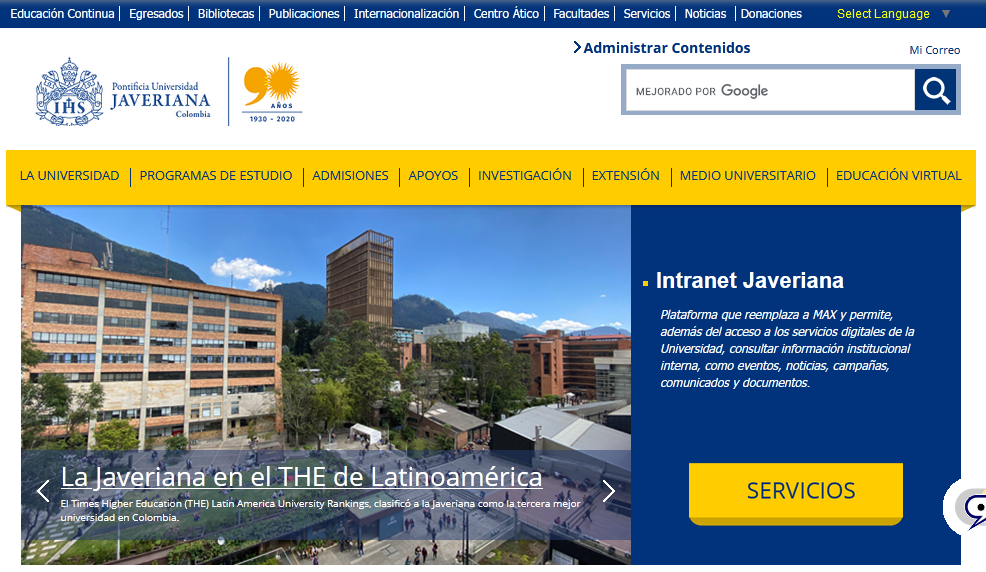
The Pontifical Javeriana University is a Colombian institution and one of the oldest universities in South America, running continuously since its formation in 1623. As well as the core university in central Bogotá, there is also the Javeriana University in the southwestern city of Cali. Javeriana is one of 28 universities on the continent run by the Jesuit organisation Friends of Jesus, whose founder Francis Xavier is for whom the university is named.
There are a total of nineteen faculties of study at Javeriana, with scientific sectors such as medicine or engineering, and humanities based areas such as the faculties of architecture and theology. In 2003 Javeriana was accredited as a high quality learning institution by the Ministry of National Education, the first university in Colombia to achieve this.
At the faculty of nursing the research groups conceptualisation and practice of nursing have been formally recognised for its excellent research by innovation institute Colciencias. Students at the faculty can take either a general nursing or specialised undergraduate degree, as well as a master’s in nursing care for the elderly.
The college at Javeriana offers exchange programmes with nations in North America, Europe, South America and Asia. There are also over a hundred student societies on campus and a Latin American Leadership programme. Courses at Javeriana teach in small class sizes, encouraging debate and interaction with fellow students.
Two former Colombian presidents have studied at Javeriana, and many diplomats attached to foreign embassies have also studied here. Notable alumni also include journalist María Cristina Caballero and businessman Luis Fernando Correa.
University of the Andes, Colombia
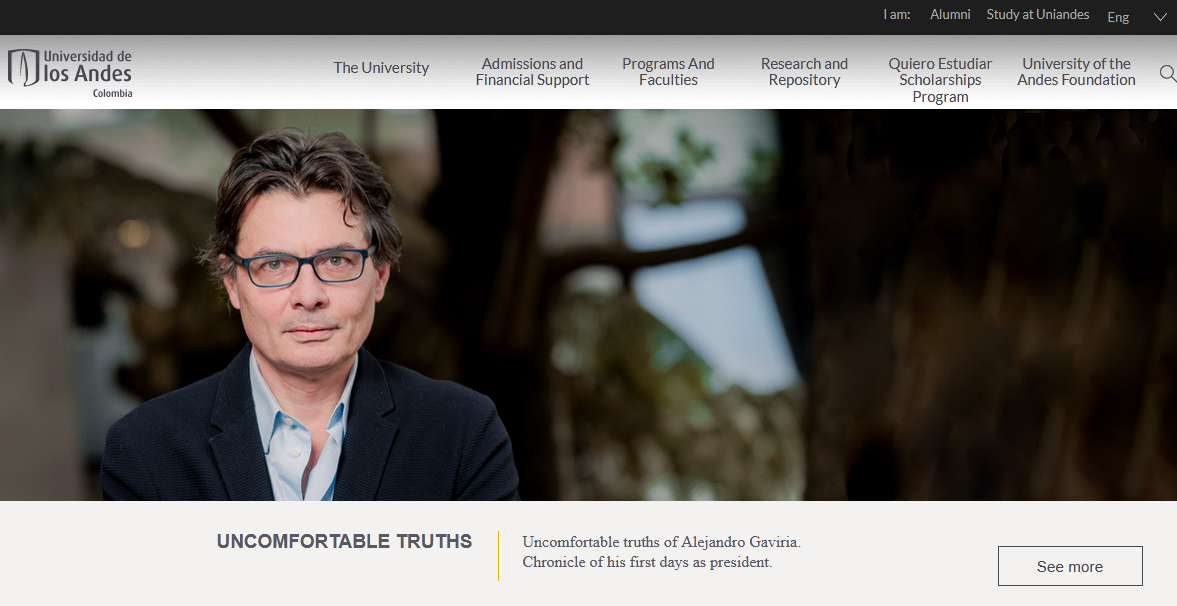
The University of the Andes, also known as Uniandes, is located in Bogotá, towards the west of Colombia. Founded in 1948 as an independent private higher education institution, it had just seven programmes, with a handful of students and teachers. It has since made its name in South America as one of the country’s leading universities.
Situated in the city centre of Bogotá – the largest city in Colombia – the university is well-connected to transport routes, the country’s financial hubbub and a vibrant local culture: classical landmarks, museums and galleries are dotted around the city and the El Dorado International Airport is a short drive away.
There are nine Schools: Medicine, Science, Engineering, Law, Economics, Social Science, Arts and Humanities, Business Administration, and Architecture and Design. This wide-ranging capacity attracts students from around the world.
It is an innovation- and research-led university with 163 laboratories, and admission is competitive. Its students tend to have a strong academic background before applying. The university aims to produce “highly skilled” and “well-rounded” graduates. Many stay on to pursue further studies. One of the most renowned alumni of the university is former president of Colombia, César Gaviria.
One of the university’s key goals is to become a “benchmark in education” and it says the curriculum flexibility offered allows students to shape their studies in line with what they are interested in. It also promotes diversity and encourages extracurricular participation in a wide range of fields, from sport clubs to societies.
The striking campus has wide green spaces and the university follows a sustainability plan to reduce its impact on the environment.
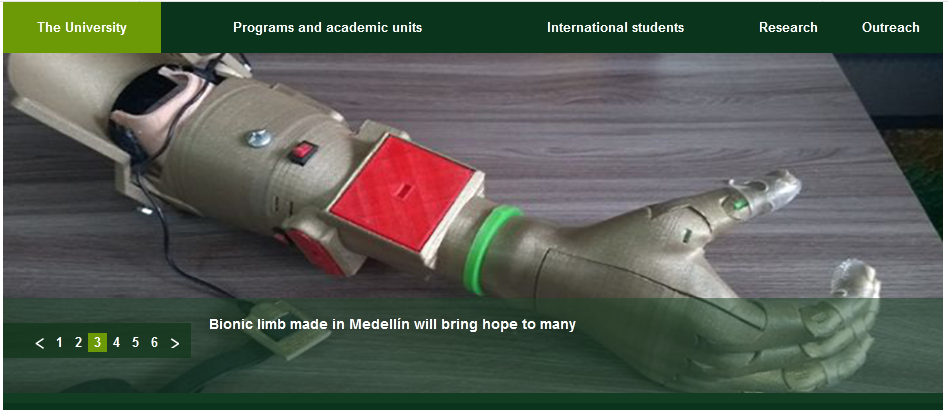
Established in 1803, under the Constitution of the State of Antioquia, the University of Antioquia is a government-run public university based in Medellín, Colombia. Its duties and its powers are prescribed in the provisions of Act 30 of 1992 of the National Constitution. The university can establish facilities and campuses anywhere across the nation as well as join or create corporations, foundations and other public or semi-public bodies. Its mission is to generate, develop and disseminate knowledge in a wide range of disciplines including humanities, science, arts, philosophy, technics and technology through research, teaching and extension activities. The university offers nationally accredited undergraduate and graduate degrees and post-baccalaureate programmes that are delivered through both face-to-face and distance learning methods.
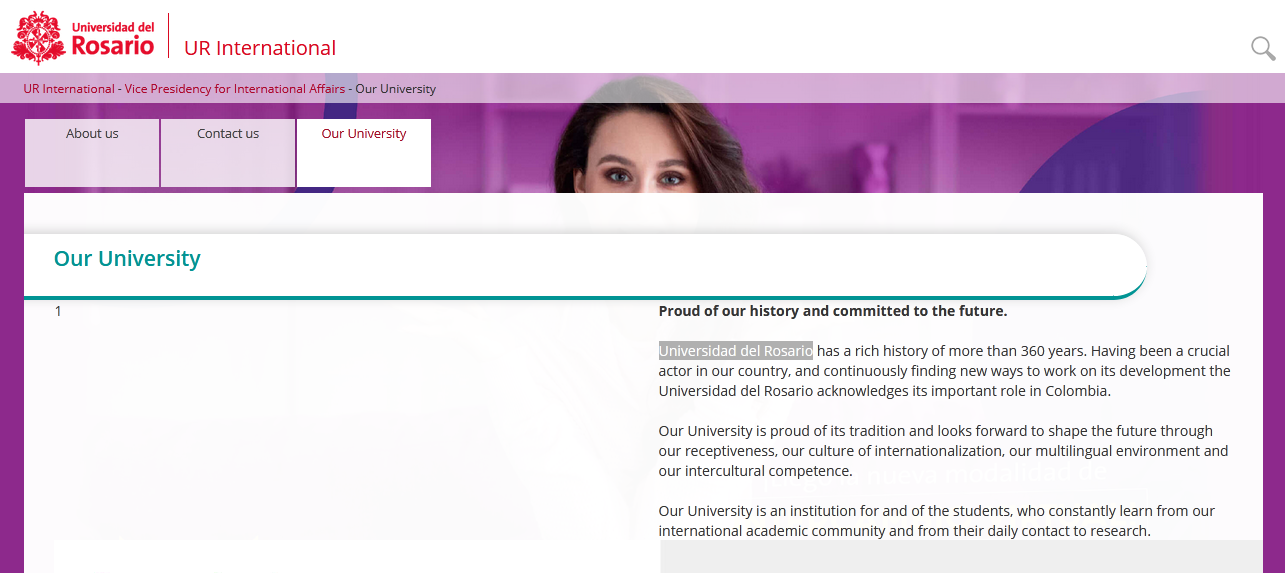
Founded by the Spanish Dominican Friar, Cristóbal de Torres, Del Rosario University (Colegio Mayor de Nuestra Señora del Rosario) is the third oldest university in Columbia and has been a working private institution since 1653, only pausing its existence in 1819 when it became a prison during General Morillo of Spain’s re-conquest of Colombian land.
Situated in the towns of La Candelaria and Santa Fe in the centre of Bogotá, it was modelled on the University of Salamanca in Spain and is one of the most prestigious private universities in the country.
It has an astounding history, having been involved with the revolution for independence from Spain and the drafting of the Political National Constitution in 1991. Its cloister was built in the colonial era in the typical 17th century-style and is listed as one of the Republic of Columbia’s National Heritage Monuments. The cloister also contains one of the country’s finest art galleries, with paintings dating back to 1700. It was printed on the 200 Columbian peso bank note (now out of circulation).
With six faculties and two schools, the university offers 20 undergraduate programs, 11 master’s, 4 PhDs and over 20 postgraduate courses in six different disciplines. There is also a primary and secondary school for boys, which forms part of the university.
Some 28 of Colombia’s presidents are former students of Del Rosario (including Andrés Pastrana, Alfonso López Michelsen and Dario Echandia) and every single government in Columbian history has featured at least one of the university’s alumni.
Industrial University of Santander (UIS)

The Industrial University of Santander (UIS) is a public university established in 1944 located in the city of Bucaramanga, Santander, Colombia. The university also has satellite campuses across the cities of Barrancabermeja, Barbosa, Málaga, Piedecuesta and Socorro.
Some would say UIS have achieved their motto, “making our future”, by being Colombia’s biggest higher education and research institution. Not only does it offer 124 programmes including 21 masters, six doctorate and nine residency programs to around 22,000 students, but it also ranks as one of the top research universities.
UIS is a leading multidisciplinary research institution based on their number of publications, technological development and research groups. It is known for its innovative research in the field of engineering, basic sciences, and medicine. The Colombian Institute of Petroleum and the National Center for Research in agrarian industry and tropical medicine are part of the university. Additionally, the University has 94 research laboratories, its own press publisher, and it’s the main academic centre associated with the Colombian Petroleum Company ECOPETROL.
UIS initially only offered engineering degrees in the field of electronics, mechanical and chemical. During the 1950s and 1960s petroleum and metallurgical engineering as well as the school of health sciences with programmes in medicine, nursing, bacteriology, nutrition, physical therapy and social work were added. Finally, in 1994, the faculty of law and political science were introduced to become the first law programme offered by a public educational institution in the north-eastern region of Colombia.
The university’s main campus, known as Campus Universitario Principal (Main University Campus, CUP), is located in the northeast part of the city and houses the faculties of sciences, engineering, and humanities. The second campus, however, is close to the University Hospital of Santander and hence contains the faculty of health in addition to a building known as Sede Bucarica, which is a national heritage monument.
Santander is located in the central Northern part of Colombia and is well known for its small towns and villages, delicious cuisine and fun activities. Visiting the Chicamocha Canyon where you can enjoy ziplining and enjoying the stunning view of the biggest Colombian canyon from the comfort of your cable-car is a must.
If you’re interested in an adrenalin rush then paragliding and extreme sports such as bungee jumping and white-water rafting are available. On the other hand, more relaxing activities such as taking a coffee tour of the beautiful Hacienda El Roble, admiring the caves and waterfall of Florian and walking the cobbled streets of Giron, one of Colombia’s 17 “Heritage Towns” is a requirement.
National University of Colombia
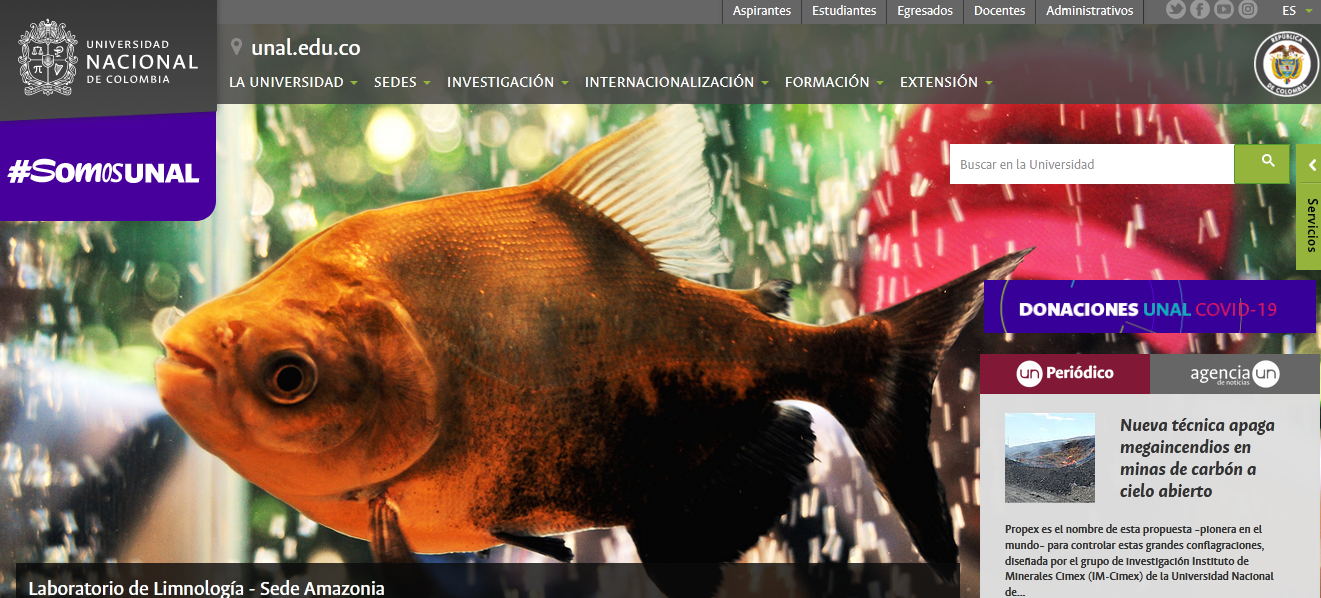
The Universidad Nacional de Colombia, or the National University of Colombia was created in 1867 by an act of the Congress of Colombia. It has since grown to become the largest higher education establishment in the country.
It has two main campuses (Bogotá and Medellín) and four satellite campuses (Manizales, Yopal and Palmira) spreading from the Caribbean to the Amazon, in some of the country’s most remote regions.
It is part of the “golden triangle” of higher education in Colombia, alongside Antioquia and Valle University, as it is one of the most selective, competitive and high achieving universities in the country. Of those who apply, only 0-10 per cent are accepted to study.
For both its research and education environments, it is often one of the most high-ranking universities in Latin America.
Students can choose from 430 academic programmes at undergraduate and postgraduate level including medicine, nursing, dentistry, engineering, chemistry, mathematics, physics, pharmacy, biology, geology, social sciences, psychology, social sciences, arts, philosophy, languages, philosophy and law.
It is one of Columbia’s only universities to employ post-doctorate fellows.
The main university campus (Ciudad Universitaria de Bogotá) is situated in the Teusaquillo locality, to the northwest of Bogotá. With a 300-acre area, it is the largest campus in Colombia and is home to the León de Greiff Auditorium and the Francisco de Paula Santander Plaza also known as the Ché Plaza, in honour of Ernesto Ché Guevara. It has its own stadium, which hosts matches for the Colombian professional football league. There is also another main campus in Medellín, split into two parts: Central Campus and Campus Robledo.
Its most notable former student is the writer Gabriel García Márquez, who studied law.
University of the North, Colombia

Universidad del Norte was founded in 1966 in Barranquilla, Colombia. Following the principles, values and objectives guiding Universidad del Norte Foundation since its creation, it has the mission of holistically forming the individual at the level of higher education and contribute through its institutional presence in the community for balanced development of society and the country, especially the Caribbean region.
The Foundation accomplishes this educational task at the undergraduate and advanced level and is characterized for its wide social and humanistic content and emphasis on scientific investigative foundations to face the challenges of the advancement of science and the social needs of the region and country.
The institution aims at developing its students as thinking, analytical individuals with solid ethical principles and innovative ideas that enable them to participate in an active, entrepreneurial, responsible, honest, critical and pragmatic way while contributing to the social, economic, political and cultural development of the community.
The University strives to recruit qualified professors with a deep academic vocation and is determined to have the most adequate and advanced teaching, research and extension methods in contemporary education. So that science, technology, humanities and arts will continue to be the distinctive institutional pillars for the formation of students.
Universidad del Norte promotes and supports its leaders, professors, students and alumni to continue studying, analyzing and investigating the concrete problems of the community where they belong. Since its origin our institution has been committed to social, economic, political, environmental and cultural development and social responsibility within society and academia.
Pontifical Bolivarian University (UPB) – Medellín
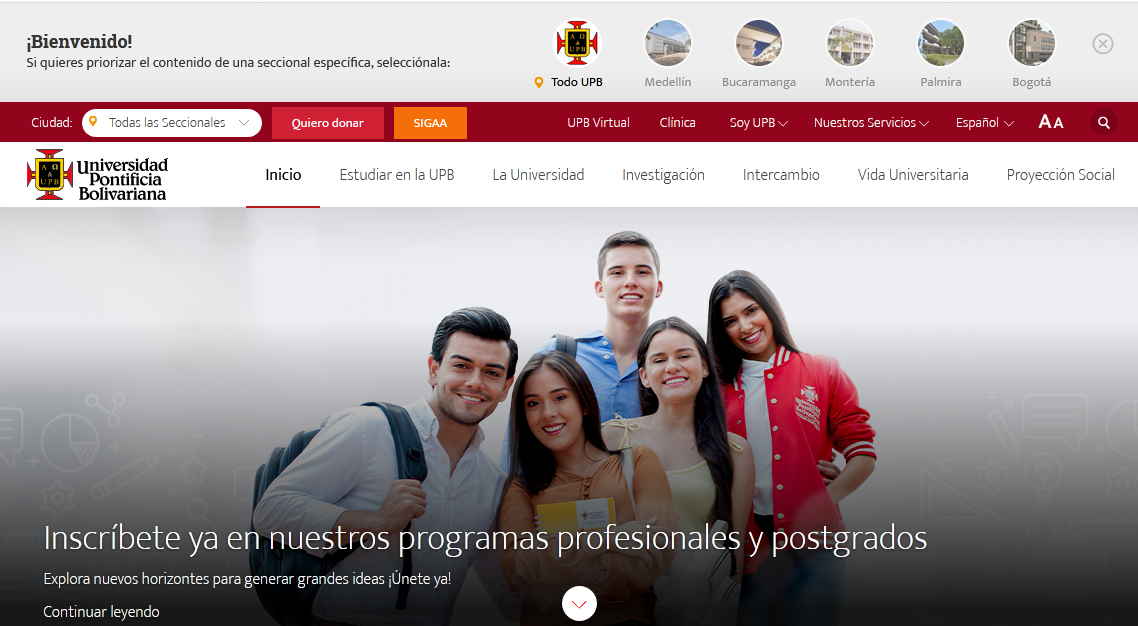
The Pontifical Bolivarian University (UPB) or Universidad Pontificia Bolivariana in Spanish was founded in 1936. It is a private university which began with 78 students enrolled in the School of Law, with Monsignor José Sierra as its first rector. The university was granted the title of Pontifical from the Holy See under Pope Pius XII in 1945. With this title, the Pope technically became the Grand Chancellor of the university.
Although its main campus is in Medellin, it also has campuses in other Colombian cities including Bogota, Bucaramanga, Monteria and Palmira. It is known for having the oldest industrial design programme in Colombia, one of the first nanotechnology programmes and the first video game design engineering programmes in the country.
It has one of the oldest and best law schools and the medical programme is known to be one of the best in the country too. At the moment, it offers 77 undergraduate programmes, 24 master’s programmes and seven doctorate programmes. UPB also operates elementary and high school programmes under its educational umbrella. As of April 2018, the Pontifical Bolivarian University estimated its nationwide student population to be 30,000.
UPB is a member of different international associations and programmes. It is also a chair of UNESCO on Human Development and a member of the Foundation for Studies in France. UPB belongs to the Sígueme Program, a group of 10 Colombian universities, and has agreements with universities across the world, including in Germany, Canada and the United Kingdom.
Several of its distinguished former students include former President of Colombia Belisario Betancur Cuartas and former First Lady of Colombia Lina Maria Moreno Mejia.
Follow us on Facebook, Twitter, LinkedIn.








